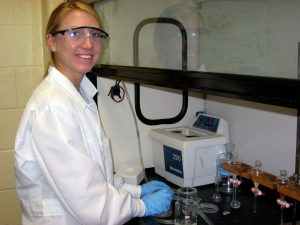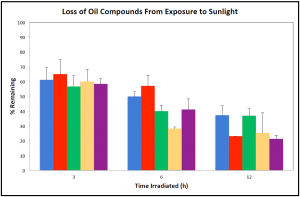Lighting the Way to Better Understanding of the Photochemistry of Oil
– January 11, 2013
“When oil gets to the surface of water, it has a limited ability to degrade. The reason is that the parts of oil that are soluble in water have already dissolved in the water and the parts that are going to evaporate and go into a gas have already done that as well. So what’s left over is relatively fixed material. Some can be biodegraded, but generally speaking, the microorganisms who consume oil usually are attracted to the molecules that more easily dissolve or evaporate, not the ones left over. That leaves one process left—photochemistry.”—Matt Tarr, University of New Orleans (UNO)
Through a GoMRI RFP-II grant-funded study “Effect of Photochemistry on Biotransformation of Crude Oil,” Dr. Tarr, along with Russ Schmehl of Tulane University and Amy Callaghan and Joe Suflita of the University of Oklahoma (OU), will look closely at how light impacts surface oil. In the same manner that sunlight hitting human skin can cause it to change colors, light hitting oil causes chemical changes that can be studied and measured.
The team will look specifically at the photoproducts produced by this chemical reaction: What are their mechanisms? Are they toxic? Are they more or less biodegradable than oil molecules that have not been exposed to light? How does the presence of dispersant affect their behavior?
In the immediate aftermath of the Deepwater Horizon Oil Spill in 2010, Dr. Tarr chartered an out-of-work fishing boat and collected oil from the surface of the Gulf of Mexico (GOM). In addition, BP gave him source oil, or oil taken directly from the well-head, to study. At UNO, Tarr will put these samples, along with the GOM water they were collected with, in a solar simulator and irradiate them for various lengths of time, with and without dispersants. At that point, they will be shipped to OU, where Callaghan and Suflita will test both the resultant water and oil separately to determine relative toxicity and biodegradability. They will also look at the biodegrading bacteria itself to see whether the presence of sunlight helps or hinders them in their work of consuming oil. Finally, Schmehl at Tulane will focus on the mechanisms of the process on a molecular level, i.e., how much light exposure causes oil molecules to enter the “excited” state required to produce photoproducts and how long this state lasts.
This study is unusual in that the researchers will not only include graduate students in the process, but undergraduates and even high school students are invited to apply to assist. Dr. Tarr hopes to both broaden the general understanding of the photochemistry of oil and to gather enough information that a modeler might be able to use the data to predict the behavior of surface oil in a future spill. He feels strongly that science needs to play a more visible role going forward in terms of the decision making process regarding energy policy, and hopes his findings might help leaders in government and industry choose wisely:
“Right now we have a lot of controversy in the United States about what’s more important—our economy and our access to energy and the things that we want or protecting our future in terms of environmental security. I think it’s extremely important that we utilize facts and knowledge about the world we live in when making any policy decisions about those issues.”—Matt Tarr, University of New Orleans
This research was made possible by a grant from BP/The Gulf of Mexico Research Initiative. The GoMRI is a 10-year, $500 million independent research program established by an agreement between BP and the Gulf of Mexico Alliance to study the effects of the Deepwater Horizon incident and the potential associated impact of this and similar incidents on the environment and public health.
© Copyright 2010- 2017 Gulf of Mexico Research Initiative (GoMRI) – All Rights Reserved. Redistribution is encouraged with acknowledgement to the Gulf of Mexico Research Initiative (GoMRI). Please credit images and/or videos as done in each article. Questions? Contact web-content editor Nilde “Maggie” Dannreuther, Northern Gulf Institute, Mississippi State University (maggied@ngi.msstate.edu).







